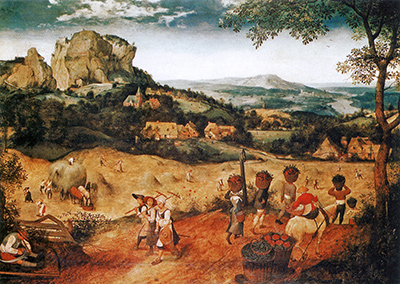Hay Harvest (1565) is an oil on wood painting by Pieter Bruegel the Elder, a Renaissance artist from the Netherlands.
This painting was part of a series of paintings, each representing parts of the year commissioned by Niclaes Jonghelinck, a wealthy patron from Antwerp.
It is possible Bruegel painted a piece for each month; however, only five paintings remain with this one included.
It is therefore also possible he painted only six to represent two months each, with one missing.
It is debated among those who study art what the actual total was. The piece Hay Harvest represents June and July as they were the months when the peasants or common folk would perform their haymaking duties.
It is characteristic of Bruegel's style as he usually painted the ordinary lives of peasants, in particular community events, as the harvest would be.
The beautifully depicted landscape is also common in Bruegel's work. Hay Harvest was created in the time when paintings had the landscape as a main feature and even as a subject of a painting, instead of being just a backdrop.
This is one of the changes in art that came along with the Renaissance as it swept throughout Europe. Today, Hay Harvest represents a lost part of society as there is far less human labour, particularly on this scale.
It provides a snapshot of what life was like for common people all those years ago. They would have had a greater connection with the land and even a bigger sense of community because they would have had to work together.
This beautiful and idyllic painting is now housed in the Lobkowicz Palace in Prague, Czech Republic as part of the Lobkowicz family collection.




